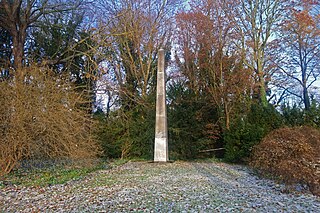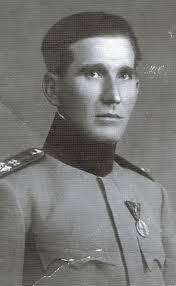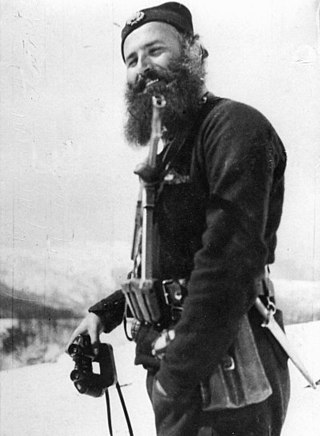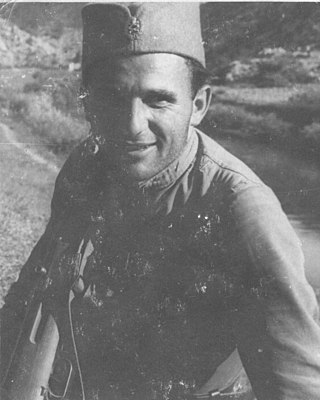
Unification or Death, popularly known as the Black Hand, was a secret military society formed in 1901 by officers in the Army of the Kingdom of Serbia. It gained a reputation for its alleged involvement in the assassination of Archduke Franz Ferdinand in Sarajevo in 1914 and for the earlier assassination of the Serbian royal couple in 1903, under the aegis of Captain Dragutin Dimitrijević.

Dragutin Dimitrijević, better known by his nickname Apis, was a Serbian army officer and chief of the military intelligence section of the general staff in 1913. He is best known as the most prominent member of the Black Hand, a secret military society that organised the 1903 overthrow of the Serbian government and assassination of King Alexander I of Serbia and Queen Draga. Some scholars believe that he also initiated the plot to kill the Archduke Franz Ferdinand in June 1914, which led to the July Crisis and the outbreak of World War I.

Bosansko Grahovo is a town and the seat of the Municipality of Bosansko Grahovo in Canton 10 of the Federation of Bosnia and Herzegovina, an entity of Bosnia and Herzegovina. It is situated in western Bosnia and Herzegovina along the border with Croatia.
The Department for Protection of the People, commonly known under its Serbo-Croatian acronym as OZNA, was the security agency of Communist Yugoslavia that existed between 1944 and 1946.

Slobodan "Braco" Dimitrijević is a Bosnian conceptual artist. His works deal mainly with history and the individual's place in it. He lives and works in Paris, France.

Tomislav Sertić was a Croatian military officer who served as the commander of all Ustaše Military Units, chief of staff of the Ustaše Militia and the Chief of the General Staff of the Armed Forces. He was captured at the end of World War II and put to death as a war criminal.

Pavle Đurišić was a Montenegrin Serb regular officer of the Royal Yugoslav Army who became a Chetnik commander (vojvoda) and led a significant proportion of the Chetniks in Montenegro during World War II. He distinguished himself and became one of the main commanders during the popular uprising against the Italians in Montenegro in July 1941, but later collaborated with the Italians in actions against the Communist-led Yugoslav Partisans. In 1943, his troops carried out several massacres against the Muslim population of Bosnia, Herzegovina, and the Sandžak in which an estimated 10,000 people were killed between January and March, including thousands of women, children, and the elderly. He then led his troops during their participation in the anti-Partisan Case White offensive alongside Italian forces. Đurišić was captured by the Germans in May 1943, escaped, and was recaptured.
Dimitrijević is a Serbian patronymic surname derived from a masculine given name Dimitrije. It may refer to:
The 81st Support Aviation Regiment was an aviation regiment established in 1944 as 2nd Yugoslav Assault Regiment formed from Yugoslav partisan aviators on training in Soviet Union.
The 117th Fighter Aviation Regiment was a unit established in 1944 as the 112th Fighter Aviation Regiment. It was formed from Yugoslav partisan aviators, who were trained and equipped by the Soviet Air Force. The regiment was deployed in the Croatian War of Independence, and is believed to be responsible of the 1991 raid on Vrsar.
The 111th Helicopter Regiment was a unit established in 1944 as the 422nd Assault Aviation Regiment.
The 107th Mixed Aviation Regiment was an aviation regiment established in 1944 as 421st Assault Aviation Regiment.

Dragutin Keserović was a Yugoslav Chetnik military commander holding the rank of lieutenant colonel and vojvoda during World War II. Keserović was likely the most active commander of Mihailović's Chetniks in Serbia.

Dragoslav Račić was a Serbian Chetnik military commander holding the rank of colonel and voivode during World War II.

Mustafa Golubić was a Serbian, and later Yugoslav, guerrilla fighter, revolutionary and intelligence agent.

Boško Todorović was a Chetnik commander and delegate of the Chetnik leader Draža Mihailović in eastern Bosnia during World War II. During the interwar period he was a major in the Royal Yugoslav Army. Following the April 1941 Axis invasion of Yugoslavia he joined Mihailović's Chetnik movement. Initially considered a moderate, he was responsible for negotiating the transfer of parts of eastern Bosnia from Italian to Chetnik administration in November 1941, after which the Chetniks massacred hundreds of Muslim civilians in the region. He also signed a collaboration agreement with the Italians to protect the Serb population in Italian-occupied areas. He was killed by the Yugoslav Partisans in February 1942, either trying to evade capture, or he was executed after a brief trial when captured in possession of compromising documents regarding collaboration with the Italians.

Mladen Žujović (1895—1969) was Serbian and Yugoslav attorney and professor of Law at Belgrade University. He was known as member of British-supported secret society Konspiracija and during the World War II as a member of the Central National Committee of the Kingdom of Yugoslavia and since 1943 commander of Yugoslav Army in the Fatherland in Dalmatia, Lika and Western Bosnia and Herzegovina.

Mane Rokvić was a Serb guerrilla commander and collaborator with the Axis occupation forces during the Second World War. Rokvić briefly became commander of the Yugoslav Partisan 4th detachment of the Sloboda Battalion during the 1941 Drvar uprising, a spontaneous resistance by the Serbian population to the genocidal activities of the Independent State of Croatia in Western Bosnia. Later and most notably, Rokvić left the communist cause to join the royalist Dinara Chetnik Division to command the King Alexander I regiment. He went on to collaborate with the Germans to fight against the Yugoslav Partisans.